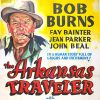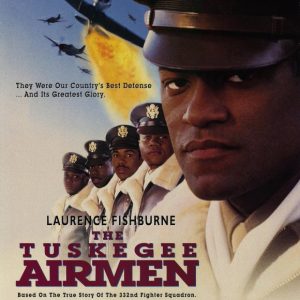calsfoundation@cals.org
The Tuskegee Airmen [Movie]
The Tuskegee Airmen was a 1995 movie dramatization of the wartime actions of the Tuskegee Airmen, a group of African American military pilots and air support crew who fought in World War II. They were the first Black flying squadron, as well as the first such squadron to deploy overseas. While the film had a brief theatrical release, it was originally made for HBO and was intended for cable television. Location shooting for the movie took place at Fort Chaffee, right outside of Fort Smith (Sebastian County). In addition, the Fort Smith Frisco Railroad Station was also utilized in filming. The barracks at Fort Chaffee had been used previously in the 1988 wartime film Biloxi Blues. Arkansas actress Natalie Canerday worked as a production secretary on the movie.
The film’s narrative centers on the experiences of Hannibal Lee Jr., played by Laurence Fishburne, and his fellow Black aspiring pilots as they join the U.S. Army and begin training under the watchful eye of a white commanding officer. The Black recruits stoically undergo the race-based abuse so common to the era, especially in the heart of the old Confederacy in Tuskegee, Alabama. In true Hollywood fashion, the aspiring pilots endure the abuse in the quest to prove themselves and earn the right to defend their country—and are ultimately successful.
Persevering through the racism, the doubts, and the abuse, the men overcome obstacles and setbacks, including a Congressional committee hearing convened to assess whether the Tuskegee program should even be continued. The men complete their training and are fully cleared for combat, becoming part of the all-Black 332 Fighter Group deployed to Italy, where they play an important role in the ultimate Allied victory.
The narrative is based on no single individual but was for the most part a compilation of events woven together. While most of the film’s characters are fictional composites, the overall impact and the historic nature of their efforts are made clear as the fictional storyline plays out. At the same time, the inclusion of some real people, like Eleanor Roosevelt—who, on a visit to the Tuskegee Army Air Field in 1941, had in fact insisted on flying with C. Alfred Anderson, the first African American to earn a pilot’s license—and General Benjamin Davis, in the dramatization, adds to the authenticity of the film, as does newsreel footage of some of the aerial combat.
The overall response to the film was positive. Given the movie’s origins in cable television, some critics observed that it did not have the majesty or power of a film intended for the big screen. At the same time, its strong cast and the use of real war footage added to the film’s power. Indeed, the stellar cast—led by Fishburne, Cuba Gooding Jr., John Lithgow, Malcolm-Jamal Warner, and Andre Braugher—was regarded as one of the undisputed strengths of the film. The movie won three Emmy Awards in technical areas, while Fishburne and Braugher were nominated for acting Emmys. Outside the television community, the film was also well received, winning the award for Outstanding Television Movie, Mini-Series or Dramatic Special at the 1996 NAACP Image Awards, with Fishburne named Outstanding Actor in that same category.
For additional information:
“The Tuskegee Airmen.” Internet Movie Database. https://www.imdb.com/title/tt0114745/ (accessed October 9, 2024).
William H. Pruden III
Ravenscroft School


 The Tuskegee Airmen Poster
The Tuskegee Airmen Poster 



Comments
No comments on this entry yet.